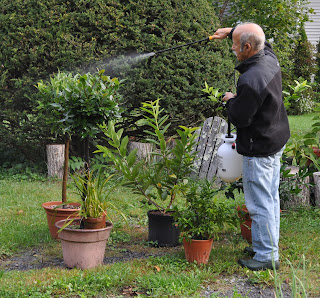Shortening days and cooling temperatures have certain potted plants crying out to be brought indoors. Soon, soon. Subtropical plants, such as bay laurel, rosemary, and fig, tolerate -- even enjoy -- temperatures below freezing, so cold isn’t the threat, for the next few weeks at least. But the later the evergreen plants come indoors, the more chance that I will have fired up the woodstove. The resulting drier air will shock plants if they’ve recently come in from cool, moist outdoor conditions; leaves will yellow and drop.
As for my poinsettia, staghorn fern, orchids, and other tropical plants, temperatures that dip below freezing could do them in.
But nobody’s coming indoors yet. First I have to make sure that no creatures are hitchhiking in with the plants. No, not creatures that would threaten me, but creatures that would threaten the plants themselves, and those would be mostly scale insects. Outdoors, ladybird beetles, parasitic wasps, some fungi, and other natural predators and diseases keep scale populations more or less in check. Indoors, plants are on their own.
Scale insects are so named for the waxy covering that protects the adults. They need that protection because once they start sucking plant juices through their straw-like stylets, they settle down in one place for good. Infested plants become weakened and the insects secrete a sticky honeydew that drips on the plant and surrounding furniture and carpet. A dark-colored fungus feeds on this honeydew, blackening leaves and surroundings. Blackening of the leaves, although superficial (the fungus isn’t attacking the plant), further weakens the plant by shading it from light.
Scale trivia: Male scale insects die after a couple of days without ever feeding. Some scale species consist only of females. Some scale insects are herded by ants who move them about and protect them from predators; in return ants “milk” the insects for their sweet honeydew. And not all scale insects are bad. Red cochineal dye comes from a scale insect, as does lacquer.
-----------------------------------------
For the past few weeks, once a week, I’ve taken out my arsenal against scale insects. Insecticidal soap is relatively nontoxic and is a kind of soap especially formulated to kill soft-bodied insects. Two teaspoons of mild detergent in a gallon of water is also effective.
Repeated applications are needed because the soap is ineffective against scale insects protected by their covering. It’s the little ones, the “crawlers,” as they are called, that I’m gunning for. After birth, they scoot out from beneath their mother’s protective cover to find their own sucking spots, and that’s when they’re most vulnerable to soap. My goal is to keep at it to kill each hatching until there’s no more fecund mothers still giving birth. If the soap merely knocks crawlers off the plant, a subsequent spray will also kill or knock off any that climb back aloft.
My last couple of sprays will be oil, which smothers protected mothers and crawlers. (I know this sounds brutal, but experience yourself a houseplant heavily infested with scale and the associated sticky, blackened carpet and furniture before passing judgement.) Oil can damage plants also, especially evergreens, so the oil to use is “horticultural” oil, also known as “summer” oil, which is highly refined to remove harmful ingredients. Like soaps, these oils are relatively nontoxic to nontarget organisms.
-----------------------------------------
Usually, scale insects hardly make their presence known until just after midwinter. I do notice a couple of scaly bumps on citrus and staghorn fern; these I deal with mano a mano, with a flick of my fingernail.
Strawberry guava, though, already has plenty of tufts of white cottony cushion scale on it. The guava also is loaded with ripening fruits so needs all the energy it can get, especially with shortening days. This tropical fruit tastes nothing like strawberry but has a sweet, perfume-y flavor with a nice tang. The reddish flesh and abundant, edible seeds probably give rise to the “strawberry” part of the name.



You're talking houseplants; it's time to ask: how did your rice do?
ReplyDeleteThanks for the reminder. The rice is harvested and . . . I'll report soon.
Delete